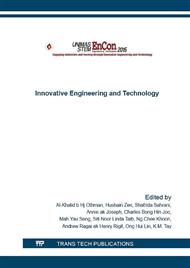p.3
p.11
p.19
p.27
p.33
p.41
p.49
p.59
Numerical Investigation of Rotational Speed on Pump as Turbine for Microhydro Applications
Abstract:
Pump as Turbine (PAT) always has been a favourable solution to generate electricity in rural areas when there is a potential microhydro site. Such systems have lower capital cost, and they are easier to maintain than commercially-available microhydro turbines. Normally, PAT is designed to run at a rated rotational speed so it can directly couple with an induction generator in order to match the synchronous speed. In an actual scenario, the PAT’s rotational speed changes and fluctuates with respect to flow rate due to the absence of a hydraulic control mechanism. It is essential to understand how the PAT behaves under different rotational speeds in order to design good microhydro systems. The aim of this study was to conduct simulation analysis of the effect of rotational speed on PAT’s performance curve over a range of flow rates. ANSYS CFX software was used as the Computational Fluid Dynamic (CFD) simulation tool in this study. Three distinct flow domains was modelled by Computer Aided Design (CAD) software and assembled as the computational fluid domains. Mesh independence analysis and convergence criteria were set to ensure the accuracy of the model. The torque generated by the impeller was collected from the simulation data and presented in the PAT performance curve. It was observed that the pressure head and torque generated increased at higher rotational speeds, thus maintaining the efficiency value. The results showed that the efficiency of the PAT was maintained around 76.5% for rotational speeds between 1350 to 1650 RPM, but the best efficiency point shifted to lower flow rate for lower rotational speed. The outcomes of this study will be useful for turbomachinery researchers, microhydro users, and project engineers for predicting the PAT performance for designing microhydro systems.
Info:
Periodical:
Pages:
11-18
Citation:
Online since:
April 2016
Authors:
Price:
Сopyright:
© 2016 Trans Tech Publications Ltd. All Rights Reserved
Share:
Citation:


